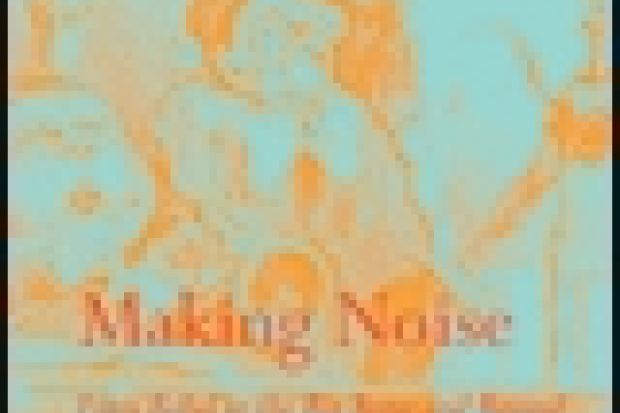During the past few years, a polemical flurry of books has risen up in quiet rage against the encroachment of noise on public and private life, all of them promoting silence as a prerequisite of well-being. I am thinking of Sara Maitland's A Book of Silence, for example, or Garret Keizer's The Unwanted Sound of Everything We Want: A Book about Noise. These pleas for sonic sanity have (forgive the pun) struck a chord with the reading public, yet their effect on actual noise seems negligible. Noise is not like smoking, after all - an addiction that can be given up if the spirit is sufficiently willing - but endemic to growth in the developed world.
Now here comes Hillel Schwartz with an explosion of a book, a Niagara Falls whose cumulative weight proposes a different view. Noise is by no means new, nor is it an objective or easily categorised auditory sensation, for the "sentiments of noise", as he terms them, are relative and contextual. "Yet the cry of a peacock in an abandoned courtyard," he writes, "the whimper of a baby in an empty stadium, or the groan of oaks under the winds of dark woods may feel louder, noisier, than any siren."
As the scholarship of sound studies has gathered pace, catching up with pioneering musicians, composers, environmental sound recordists and sound artists, so a need for histories of listening has become increasingly obvious. Noise is notoriously difficult to define. Is it an evolutionary response to any sound that reminds us of bears roaring in a cave? Is it hard-wired aversion to dissonance and loudness, or simply a catch-all term used by citizens who possess power to significantly affect their environment? None of these satisfies, although the latter, with its Nimbyish air of "what I don't like" seems to be the current favourite. Read far enough into Making Noise, however, and all facets of life come alive with sounds good, bad and ugly. They are existence itself.
Every shift in human culture, whether theological diktat, military killing machine, medical environment or communication device, has dragged unheard sounds into the sensorium. These were noise because they were novel; in time many such sounds would come to seem natural and so fade into a perceived inaudibility to be replaced by the next visitation from auditory hell. Appropriately, Schwartz has responded to this superabundance with a book whose noisiness embraces steel tools, devils, listening in darkness, stethoscopes, bedlam, escape from slavery, a multitude of wars, steam, flatulence, shirt-making, ears in folklore, sex, the static heard in telegraphers' headsets, pneumatic door checks, cosmology, street bands, smog and the relationship of diabetes to deafness.
If that list sounds exhaustive, then believe me when I say it barely scratches a multitude of surfaces. Making Noise is written in thick prose, certainly readable and absorbing in both sweep and detail, yet it also threatens to overwhelm in its reluctance to let even the smallest sound pass without remark. Schwartz quotes pleasingly from Finnegans Wake - "man made static and bawling the whowle hamshack and wobble" - and there is something of James Joyce's compulsion to gobble and regurgitate all of life (auditory life at least) in the relentless verve of his research. As Public Enemy once rapped, Bring the Noise.
An unavoidable conclusion to be drawn from such a cornucopia of evidence is the cyclical nature of complaints concerning noise, innovation and technology. Many of the ailments of listening we regard as uniquely 21st century are, in fact, old news. Take "telephone illness", for example, a syndrome supposedly affecting anaemic young women, who, "allured by telephonic vibrations and holding the receiver far too amorously to their ears, became dizzy at the slightest of external noises". A typical red-top health scare circa round-about-now, one might assume, but no, this was documented in 1897.
Similarly, the need for privacy in telephone conversations raised anxieties about the level of street noise heard at the dawn of the 20th century, "where heavily laden trucks and wagons, rattling over the cobblestone streets, the hum of street car motors and the clang of their bells...make talking in a public place well-nigh impossible". This is an important book, then, for leading the discourse of listening away from narrow morality and a limited frame of reference. We are forced to admit that noise may threaten health and sanity, yet it represents energy, invention, the buzz of life. As Schwartz makes abundantly clear, "noise inhabits an historical space", and so demands greater understanding.
Making Noise: From Babel to the Big Bang and Beyond
By Hillel Schwartz
Zone Books, 912pp, £26.95
ISBN 9781935408123
Published 16 December 2011
Register to continue
Why register?
- Registration is free and only takes a moment
- Once registered, you can read 3 articles a month
- Sign up for our newsletter
Subscribe
Or subscribe for unlimited access to:
- Unlimited access to news, views, insights & reviews
- Digital editions
- Digital access to THE’s university and college rankings analysis
Already registered or a current subscriber? Login
